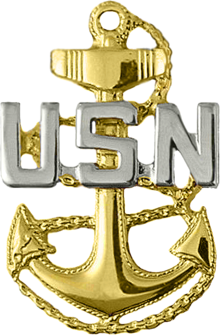
Foul is a nautical term meaning to entangle or entwine, and more generally that something is wrong or difficult. The term dates back to usage with wind-driven sailing ships.

Foul is a nautical term meaning to entangle or entwine, and more generally that something is wrong or difficult. The term dates back to usage with wind-driven sailing ships.
It is usually applied to the state of an anchor, which has become hooked on some impediment on the seafloor, or has its cable wound round the stock or flukes. The term is generally utilized when speaking of items of historical value such as the US Navy chief petty officer emblem. [1] The foul anchor is also the official seal of the Lord High Admiral of the United Kingdom. The position is currently vacant. The seal is flown on the ship carrying the monarch to sea. It is also flown during the launching of a warship of the Royal Navy. The fouled anchor is also depicted on the emblem of the U.S. Public Health Service. Ships would display a fouled anchor to indicate to officers on shore that sick persons were on board, prompting further investigation and possible quarantine.[ citation needed ]
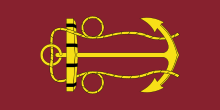
The term can be applied to many nautical situations:
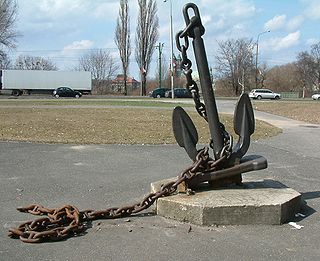
An anchor is a device, normally made of metal, used to secure a vessel to the bed of a body of water to prevent the craft from drifting due to wind or current. The word derives from Latin ancora, which itself comes from the Greek ἄγκυρα.

A ship is a large watercraft that travels the world's oceans and other sufficiently deep waterways, carrying cargo or passengers, or in support of specialized missions, such as defense, research and fishing. Ships are generally distinguished from boats, based on size, shape, load capacity and purpose. Ships have supported exploration, trade, warfare, migration, colonization, and science. Ship transport is responsible for the largest portion of world commerce.

Seamanship is the art, knowledge and competence of operating a ship, boat or other craft on water. The Oxford Dictionary states that seamanship is "The skill, techniques, or practice of handling a ship or boat at sea."

A dinghy is a type of small boat, often carried or towed by a larger vessel for use as a tender. Utility dinghies are usually rowboats or have an outboard motor. Some are rigged for sailing but they differ from sailing dinghies, which are designed first and foremost for sailing. A dinghy's main use is for transfers from larger boats, especially when the larger boat cannot dock at a suitably-sized port or marina.

A mooring is any permanent structure to which a seaborne vessel may be secured. Examples include quays, wharfs, jetties, piers, anchor buoys, and mooring buoys. A ship is secured to a mooring to forestall free movement of the ship on the water. An anchor mooring fixes a vessel's position relative to a point on the bottom of a waterway without connecting the vessel to shore. As a verb, mooring refers to the act of attaching a vessel to a mooring.

A navigator is the person on board a ship or aircraft responsible for its navigation. The navigator's primary responsibility is to be aware of ship or aircraft position at all times. Responsibilities include planning the journey, advising the ship's captain or aircraft commander of estimated timing to destinations while en route, and ensuring hazards are avoided. The navigator is in charge of maintaining the aircraft or ship's nautical charts, nautical publications, and navigational equipment, and they generally have responsibility for meteorological equipment and communications. With the advent of satellite navigation, the effort required to accurately determine one's position has decreased by orders of magnitude, so the entire field has experienced a revolutionary transition since the 1990s with traditional navigation tasks, like performing celestial navigation, being used less frequently. Using multiple independent position fix methods without solely relying on electronic systems subject to failure helps the navigator detect errors. Professional mariners are still proficient in traditional piloting and celestial navigation.

A longboat is a type of ship's boat that was in use from circa 1500 or before. Though the Royal Navy replaced longboats with launches from 1780, examples can be found in merchant ships after that date. The longboat was usually the largest boat carried. In the early period of use, a ship's longboat was often so large that it could not be carried on board, and was instead towed. For instance, a survey of 1618 of Royal Navy ship's boats listed a 52 ft 4 in longboat used by the First Rate Prince, a ship whose length of keel was 115 ft. This could lead to the longboat being lost in adverse weather. By the middle of the 17th century it became increasingly more common to carry the longboat on board, though not universally. In 1697 some British ships in chase of a French squadron cut adrift the longboats they were towing in an attempt to increase their speed and engage with the enemy.

Boat building is the design and construction of boats and their systems. This includes at a minimum a hull, with propulsion, mechanical, navigation, safety and other systems as a craft requires.
This glossary of nautical terms is an alphabetical listing of terms and expressions connected with ships, shipping, seamanship and navigation on water. Some remain current, while many date from the 17th to 19th centuries. The word nautical derives from the Latin nauticus, from Greek nautikos, from nautēs: "sailor", from naus: "ship".

A chief mate (C/M) or chief officer, usually also synonymous with the first mate or first officer, is a licensed mariner and head of the deck department of a merchant ship. The chief mate is customarily a watchstander and is in charge of the ship's cargo and deck crew. The actual title used will vary by ship's employment, by type of ship, by nationality, and by trade: for instance, chief mate is not usually used in the Commonwealth, although chief officer and first mate are; on passenger ships, the first officer may be a separate position from that of the chief officer that is junior to the latter.

A third mate (3/M) or third officer is a licensed member of the deck department of a merchant ship. The third mate is a watchstander and customarily the ship's safety officer and fourth-in-command. The position is junior to a second mate. Other duties vary depending on the type of ship, its crewing, and other factors.
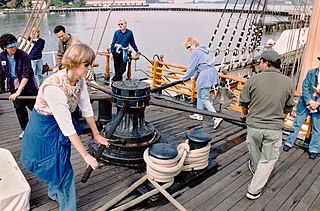
A capstan is a vertical-axled rotating machine developed for use on sailing ships to multiply the pulling force of seamen when hauling ropes, cables, and hawsers. The principle is similar to that of the windlass, which has a horizontal axle.

Careening is a method of gaining access to the hull of a sailing vessel without the use of a dry dock. It is used for cleaning or repairing the hull. Before ship's hulls were protected from marine growth by fastening copper sheets over the surface of the hull, fouling by this growth would seriously affect the sailing qualities of a ship, causing a large amount of drag.

Marine salvage is the process of recovering a ship and its cargo after a shipwreck or other maritime casualty. Salvage may encompass towing, lifting a vessel, or effecting repairs to a ship. Protecting the coastal environment from oil spillages or other contaminants from a modern ship can also be a motivator, as oil, cargo, and other pollutants can easily leak from a wreck.
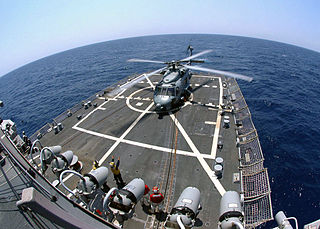
A helicopter deck is a helicopter pad on the deck of a ship, usually located on the stern and always clear of obstacles that would prove hazardous to a helicopter landing. In the United States Navy, it is commonly and properly referred to as the flight deck.

Modern United States Navy aircraft carrier air operations include the operation of fixed-wing and rotary aircraft on and around an aircraft carrier for performance of combat or noncombat missions. The flight operations are highly evolved, based on experiences dating back to 1922 with USS Langley.

A carrier-based aircraft is a naval aircraft designed for operations from aircraft carriers. Carrier-based aircraft must be able to launch in a short distance and be sturdy enough to withstand the abrupt forces of launching from and recovering on a pitching deck. In addition, their wings are generally able to fold up, easing operations in tight quarters.
This glossary of nautical terms is an alphabetical listing of terms and expressions connected with ships, shipping, seamanship and navigation on water. Some remain current, while many date from the 17th to 19th centuries. The word nautical derives from the Latin nauticus, from Greek nautikos, from nautēs: "sailor", from naus: "ship".

The Futami class was a class of oceanographic research ship of Japan Maritime Self-Defense Force (JMSDF) in the late 1970s.

JS Nichinan (AGS-5105) is the only ship of her type of oceanographic research ship for the Japan Maritime Self-Defense Force.
{{cite book}}: CS1 maint: location missing publisher (link)